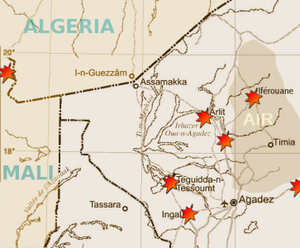Second Tuareg Rebellion
| Tuareg rebellion (2007–2009) | |||||||
|---|---|---|---|---|---|---|---|
| Part of | |||||||
 Map of attacks |
|||||||
|
|||||||
| Belligerents | |||||||
|
|
Niger: 23 May ADC Group ATMNC (2008 split) |
||||||
| Commanders and leaders | |||||||
|
|
Niger: Ibrahim Ag Bahanga Hassan Fagaga |
||||||
| Strength | |||||||
|
Niger: 4,000 to 12,000 Mali: unknown |
Niger: 500-2,000 Mali: 165-400+ |
||||||
| Casualties and losses | |||||||
|
Niger: ~70-159 killed 100+ captured Mali: ~60 killed |
~200 killed | ||||||
|
Civilian casualties: at least 10 Malian, 10 – hundreds of Nigerien civilians killed |
|||||||
Niger:
Niger Movement for Justice
Front of Forces for Rectification (2008 split)
Niger Patriotic Front (2009 split)
Niger:
Aghaly ag Alambo
Niger: 4,000 to 12,000
Niger: 500-2,000
Civilian casualties:
The Tuareg Rebellion of 2007–2009 was an insurgency that began in February 2007 amongst elements of the Tuareg people living in the Sahara desert regions of northern Mali and Niger. It is one of a series of insurgencies by formerly nomadic Tuareg populations, which had last appeared in the mid-1990s, and date back at least to 1916. Populations dispersed to Algeria and Libya, as well as to the south of Niger and Mali in the 1990s returned only in the late 1990s. Former fighters were to be integrated into national militaries, but the process has been slow and caused increased resentment. Malian Tuaregs had conducted some raids in 2005–2006, which ended in a renewed peace agreement. Fighting in both nations was carried on largely in parallel, but not in concert. While fighting was mostly confined to guerrilla attacks and army counterattacks, large portions of the desert north of each nation were no-go zones for the military and civilians fled to regional capitals like Kidal Mali and Agadez Niger. Fighting was largely contained within Mali's Kidal Region and Niger's Agadez Region. Algeria helped negotiate an August 2008 Malian peace deal, which was broken by a rebel faction in December, crushed by the Malian military and wholescale defections of rebels to the government. Niger saw heavy fighting and disruption of Uranium production in the mountainous north, before a Libyan backed peace deal, aided by a factional split among the rebels, brought a negotiated ceasefire and amnesty in May 2009.
Attacks beginning in February 2007 by the Niger Movement for Justice (MNJ) targeted outposts of the Nigerien Armed Forces and foreign economic interests. The group said they were fighting for greater economic development and a share in the region's mineral wealth, an end to alleged pollution caused by and poverty surrounding the mining operations at Arlit. The area of Niger affected is home to some of the world's largest uranium deposits, and the French operated uranium mines of the desert town of Arlit account for a fifth of the world's uranium deposits and most of Niger's foreign exchange income.
...
Wikipedia
